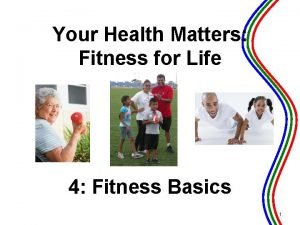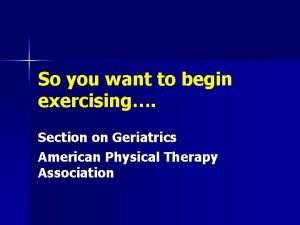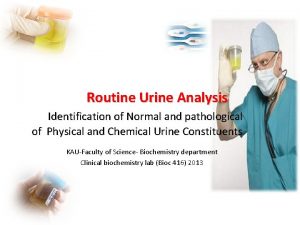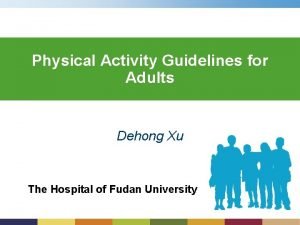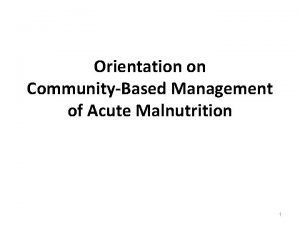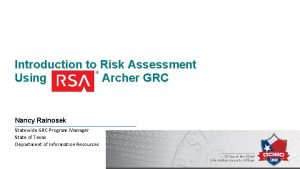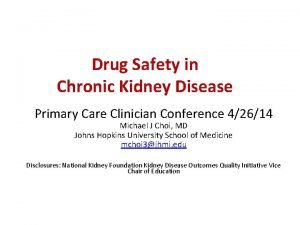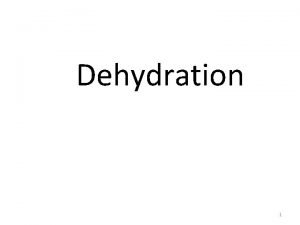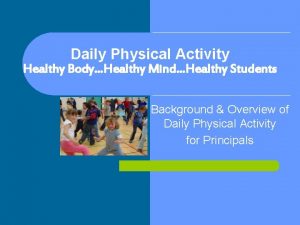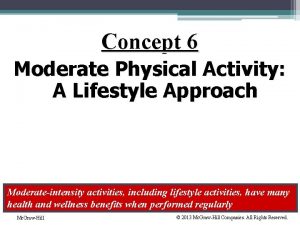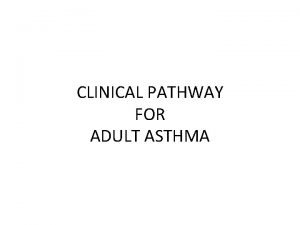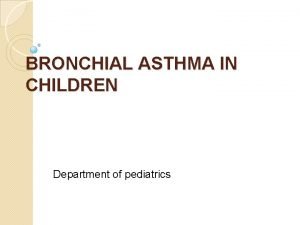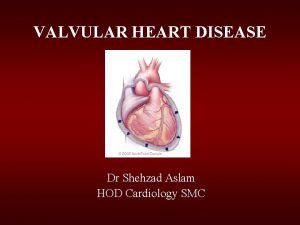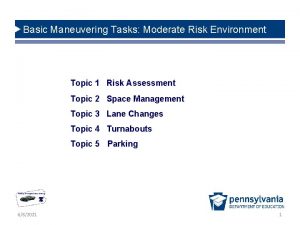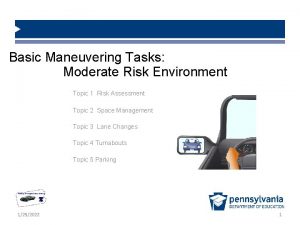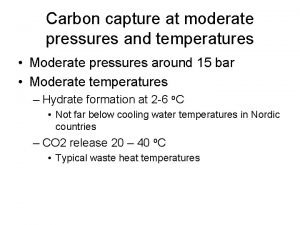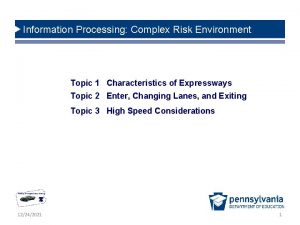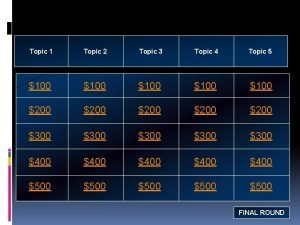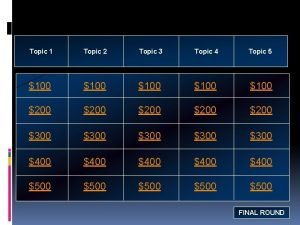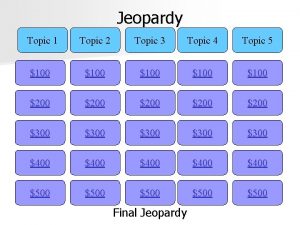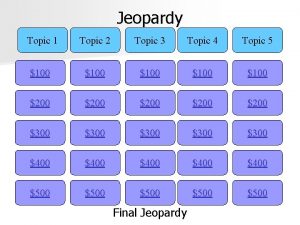Information Processing Moderate Risk Environment Topic 1 Processing





























- Slides: 29

Information Processing: Moderate Risk Environment Topic 1 Processing Information Topic 2 Intersections, Curves, and Hills Topic 3 Passing 6/14/2021 1

Basic Requirements for Driving DRIVER REQUIREMENTS VISIBILITY. . . SPACE. . . TIME. . . SPACE. . . TRACTION VEHICLE REQUIREMENTS 6/14/2021 2

Space Management System Components q Search for objects or conditions q Evaluate the path ahead for alternate paths of travel q Prepare to make adjustments in speed and/or position Searching includes: Ø Where to search Ø When to search Ø How to search Ø What to search for 6/14/2021 3

Visual Fields 6/14/2021 4

Search Practices 6/14/2021 5

Communicating 6/14/2021 6

Managing Visual Searches 6/14/2021 7

Managing Visual Searches 6/14/2021 8

Determining Following Intervals A two to four second following interval is intended to provide time to steer and is acceptable only in heavy traffic flows. It provides time to brake to a stop only if you are monitoring the actions of drivers 8 to 12 seconds ahead in your path of travel. In most instances, it necessitates steering to alternate escape path. 6/14/2021 9

Visual Search Categories • Traffic Controls • Motor Vehicles • Non-Motorized Users • Highway 6/14/2021 10

Highway Conditions 6/14/2021 11

Traffic Controls 6/14/2021 12

Motor Vehicles 6/14/2021 13

Non-Motorized Users 6/14/2021 14

Controlling Space to the Front v Timing your Arrival v Forward placement v Following interval 6/14/2021 15

Make Space with Lane Position Within Lane Positions 6/14/2021 16

Staggered Stops Stop behind the: Stop Bar Crosswalk Road Edge Position Vehicle Toward Right Side of Lane 6/14/2021 17

Intersection Search Patterns Intersection Approach Check open areas, then closed areas to front Check to the rear Communicate as necessary Check areas adjacent to path of travel Check sightlines left and right Adjust speed and/or position as appropriate 6/14/2021 18

Lane Markings Shared Left Turn Lane 6/14/2021 Reversible Lanes 19

Line of Sight Through Curve Ø Ø Ø Establish Line of Sight and Projected Path of Travel Check to the Rear Adjust Position for Maximum View of Oncoming Traffic Establish Target Area for Path of Travel Adjust Speed and Position to Conditions 6/14/2021 20

Line of Sight Through Curves 6/14/2021 21

Line of Sight Through Curves 6/14/2021 22

Line of Sight Over Hill • Sightline Limitations Similar to Curve • Adjustments are Speed Reduction and Position to the Right or outside of Lane • Restriction to Sightline is Up or Down 6/14/2021 23

Determining Passing Time/Space Needs 1 -2 second return to lane 40 mph = 60 feet 74 feet/second @ 50 mph 3 lengths of car per second may take 8 to 10 seconds to pass another car 2 -3 seconds start pass 40 mph = 120 feet 6/14/2021 24

Passing Needs Constant: 1 mph = 1. 4667 or 1. 5 feet per second (fps) Time to pass = distance traveled to complete pass, divided by difference in distance traveled per second by each vehicle, 30 mph = 45 fps 40 mph = 60 fps 60 ft - 45 ft = 15 ft. 6/14/2021 2 sec. Following Distance = 120 ft. 1 car length = 15 ft. 1 sec. Lead = 60 ft. Total additional distance traveled = 195 ft. Time needed to pass: 195/15 = 13 sec. Total distance traveled: 13 sec. X 60 fps. = 780 ft. 25

Passing Considerations • Larger Vehicles – 24 seconds to pass tractor trailer rig (90 feet) traveling @ 50 mph, when passing @ 60 mph – 2160 feet needed to complete 24 -second pass • Oncoming Vehicles – Approaching vehicle travels 2160 feet @ 60 mph – Total clear distance needed to pass becomes 4320 feet when approaching vehicles exist • Daylight Headlight Use Critical 6/14/2021 26

Passing Procedures Prepare to Pass – Position your self two to three seconds behind the vehicle you want to pass – Check mirrors and oncoming traffic – Check ahead for safe passing distance – Signal your intention 6/14/2021 27

Passing Procedures Overtake the ongoing car – – Signal and accelerate into passing lane Accelerate quickly to an appropriate speed Concentrate on the path ahead Check your mirror following cars Return to lane 6/14/2021 – – Check for the front of the car you are passing Signal intention Change lanes and maintain speed Cancel turn signal 28

Contact/Mission For more information on Driver’s Education and Safety please visit PDE’s website at www. education. pa. gov The mission of the Department of Education is to ensure that every learner has access to a world-class education system that academically prepares children and adults to succeed as productive citizens. Further, the Department seeks to establish a culture that is committed to improving opportunities throughout the commonwealth by ensuring that technical support, resources, and optimal learning environments are available for all students, whether children or adults. 6/14/2021 29
 Moderate risk environment
Moderate risk environment Liquidity measures
Liquidity measures Example of a clincher
Example of a clincher Narrow down topic
Narrow down topic Financial environment in business environment
Financial environment in business environment Module 4 topic 5 turnabouts and parking
Module 4 topic 5 turnabouts and parking Module 4 topic 1 assessing and managing risk
Module 4 topic 1 assessing and managing risk Light to moderate exercise
Light to moderate exercise Activity sheet 3: stock market calculations answer key
Activity sheet 3: stock market calculations answer key The stock market game activity sheet 1 answers
The stock market game activity sheet 1 answers Light to moderate exercise
Light to moderate exercise Urinalysis sediment
Urinalysis sediment Moderate activity examples
Moderate activity examples Vigorous activity examples
Vigorous activity examples Katrine zhiroff
Katrine zhiroff Moderate acute malnutrition
Moderate acute malnutrition Moderate spending
Moderate spending High moderate low scale
High moderate low scale Icd 10 ild
Icd 10 ild Firewall fitness
Firewall fitness Moderate renal impairment egfr
Moderate renal impairment egfr Mild moderate severe dehydration
Mild moderate severe dehydration Types of dehydration
Types of dehydration Moderate physical activity examples
Moderate physical activity examples Moderate physical activity
Moderate physical activity Asthma clinical pathway
Asthma clinical pathway Asthma grades
Asthma grades Mild moderate severe asthma exacerbation
Mild moderate severe asthma exacerbation Moderate anxiety symptoms
Moderate anxiety symptoms Moderate ms in heart
Moderate ms in heart







